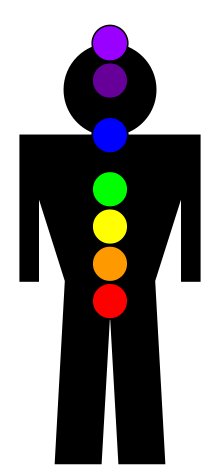- Chromotherapy
-
Chromotherapy Intervention MeSH D016500 Energy medicine - edit NCCAM classifications - Alternative Medical Systems
- Mind-Body Intervention
- Biologically Based Therapy
- Manipulative Methods
- Energy Therapy
See also Chromotherapy, sometimes called color therapy, colorology or cromatherapy, is an alternative medicine method. It is said that a therapist trained in chromotherapy can use color and light to balance "energy" wherever a person's body be lacking, be it physical, emotional, spiritual, or mental. The practice has been labelled pseudoscientific by its critics.
Color therapy is unrelated to light therapy, a valid and proven form of medical treatment for seasonal affective disorder and a small number of other conditions.
Contents
History
Avicenna (980-1037), who viewed color to be of vital importance in diagnosis and treatment, discussed chromotherapy in The Canon of Medicine. He wrote that "Color is an observable symptom of disease" and also developed a chart that related color to the temperature and physical condition of the body. His view was that red moved the blood, blue or white cooled it, and yellow reduced muscular pain and inflammation. He further discussed the properties of colors for healing and was "the first to establish that the wrong color suggested for therapy would elicit no response in specific diseases." As an example, "he observed that a person with a nosebleed should not gaze at things of a brilliant red color and should not be exposed to red light because this would stimulate the sanguineous humor, whereas blue would soothe it and reduce blood flow."[1]
Robert Hunt a scientist from the United Kingdom wrote "Researches on Light in its chemical relations" in 1844 the book described the influences of plant growth of selected applications of light.
American Civil War General Augustus Pleasonton conducted his own experiments and published his book The Influence Of The Blue Ray Of The Sunlight And Of The Blue Color Of The Sky, published in 1876 about how the color blue can improve the growth of crops and livestock and can help heal diseases in humans. This led to a birth of modern chromotherapy, influencing scientist Dr. S. Pancoast and Edwin Dwight Babbitt to conduct experiments and publish books about chromotherapy. Dr. S. Pancoast wrote "Blue and Red Light; or, Light and Its Rays as Medicine" in 1877 and Edwin Dwight Babbitt wrote "The Principles of Light and Color" in 1878.
Dinshah P. Ghadiali a Hindu scientist discovered the scientific principles which explain why and how the different colored rays have various therapeutic effects on organisms. In 1933, after years of research, Ghadiali published "The Spectro Chromemetry Encyclopaedia", a master work on color therapy. He stated that colors represent chemical potencies in higher octaves of vibration. And for each organism and system of the body there is a particular color that stimulates and another that inhibits the work of that organ or system. By knowing the action of the different colors upon the different organs and systems of the body, one can apply the correct color that will tend to balance the action of any organ or system that has become abnormal in its functioning or condition.[2]
After this, throughout the 19th century, healers claimed colored glass filters could treat many diseases including constipation and meningitis. Photobiology, the term for the contemporary scientific study of the effects of light on humans, has replaced the term chromotherapy in an effort to separate it from its roots in Victorian mysticism and to strip it of its associations with symbolism and magic.[3]
Light therapy is a specific treatment approach using high intensity light to treat specific sleep, skin and mood disorders.
Meaning of colors
Ayurvedic medicine describes the body as having seven main chakras, which are spiritual centers located along the spine that are associated with a color, function and organ or bodily system. According to this explanation, these colors can become imbalanced and result in physical diseases but these imbalances can be corrected through using the appropriate color as a treatment.[4] The purported colors and their associations are described as:[5]
Color Chakra Chakra location Alleged function Associated system Red First Base of the spine Grounding and Survival Gonads, kidneys, spine, sense of smell Orange Second Lower abdomen, genitals Emotions, sexuality Urinary tract, circulation, reproduction Yellow Third Solar plexus Power, ego Stomach, liver, gall bladder, pancreas Green Fourth Heart Love, sense of responsibility Heart, lungs, thymus Blue Fifth Throat Physical and spiritual communication Throat, ears, mouth, hands Indigo Sixth Just above the center of the brow, middle of forehead Forgiveness, compassion, understanding Eye, pineal glands Violet Seventh Crown of the head Connection with universal energies, transmission of ideas and information Pituitary gland, the central nervous system and the cerebral cortex Criticism
Chromotherapy has been deemed pseudoscience by its critics, who state that the falsifiability and verifiability conditions necessary to deem an experiment valid are not being met, and therefore that it has not been proven that introducing colors is the key element in the healing process which is healing its patients. Chromotherapy has also been criticized for selection bias in statistics of success for the treatment. It has also been suggested that the placebo effect may be a key factor in the healing of some patients, which could be tested for by a chromotherapy control group.[7]
See also
References
- ^ Azeemi, Y; Raza SM (2005). "A Critical Analysis of Chromotherapy and Its Scientific Evolution". Evidence-Based Complementary Alternative Medicine 2 (4): 481–488. doi:10.1093/ecam/neh137. PMC 1297510. PMID 16322805. http://www.pubmedcentral.nih.gov/articlerender.fcgi?tool=pmcentrez&artid=1297510.
- ^ Mary Anderson, Colour Therapy, The Aquarian Press, 1986
- ^ Gruson, L (1982-10-19). "Color has a powerful effect on behavior, researchers assert". The New York Times. http://www.nytimes.com/1982/10/19/science/color-has-a-powerful-effect-on-behavior-researchers-assert.html?&pagewanted=all. Retrieved 2009-09-18.
- ^ Parker, D (2001). Color Decoder. Barron's. ISBN 0764118870.
- ^ van Wagner, K. "Color Psychology: How Colors Impact Moods, Feelings, and Behaviors". About.com. http://psychology.about.com/od/sensationandperception/a/colorpsych.htm. Retrieved 2009-09-18.
- ^ http://www.waterfalloflight.com/gpage.html
- ^ Carey, SS (2004). A Beginner's Guide to Scientific Method. Wadsworth Publishing. ISBN 0534584500.
External links
Categories:- Color
- Energy therapies
- Pseudoscience
Wikimedia Foundation. 2010.



